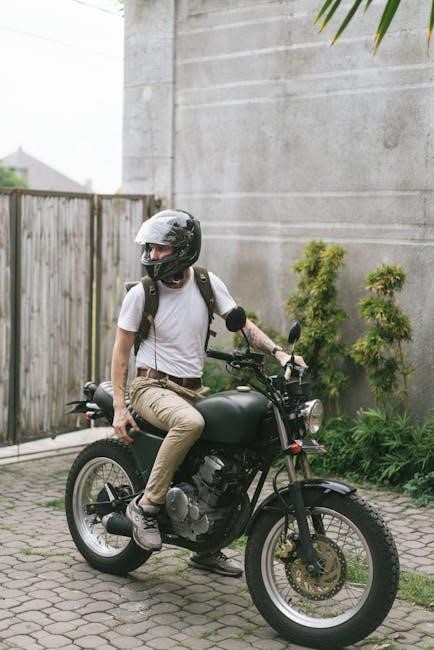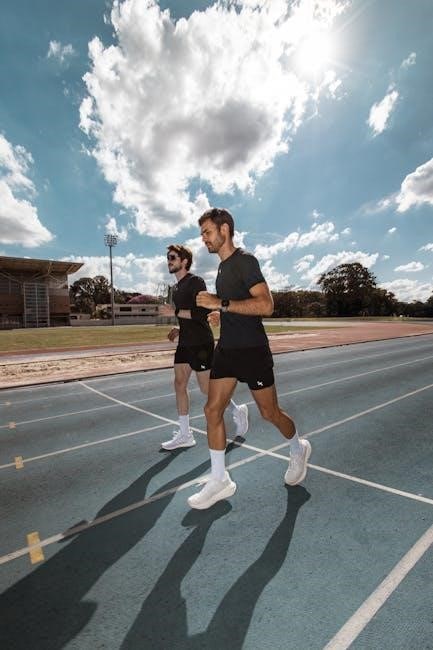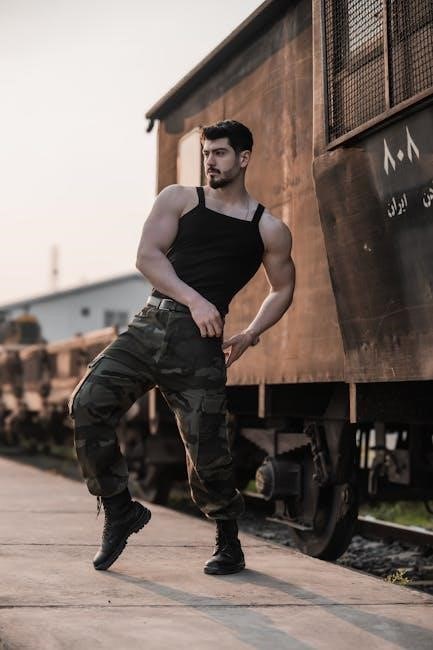men’s pants fit guide
A well-fitted pair of pants is essential for both style and comfort. This guide helps you navigate through styles‚ measurements‚ and fabrics to find your perfect match.

Importance of Proper Fit in Men’s Pants
A proper fit in men’s pants is crucial for both style and comfort. Ill-fitting pants can lead to discomfort‚ restricted movement‚ and an unpolished appearance. Baggy pants may look sloppy‚ while overly tight styles can cause discomfort. A well-fitted pair enhances confidence‚ creating a sharp‚ put-together look. Proper fit also ensures durability‚ as pants that aren’t strained by tight waistbands or excessive fabric last longer. Whether for formal or casual occasions‚ the right fit elevates your entire outfit‚ making it essential to invest time in finding pants that flatter your body type and meet your lifestyle needs.
Understanding Body Types and Their Impact on Pant Fit
Body type significantly influences pant fit‚ with ectomorphs‚ mesomorphs‚ and endomorphs requiring tailored approaches. Ectomorphs‚ with lean builds‚ benefit from slim or straight-leg styles to add structure. Mesomorphs‚ athletic and muscular‚ need pants with a balanced fit to accommodate thighs while maintaining a streamlined look. Endomorphs‚ broader and curvier‚ find comfort in relaxed or loose-fit pants that provide support without restriction. Understanding your body type helps in selecting styles and sizes that enhance comfort and aesthetics‚ ensuring pants flatter your physique and meet your lifestyle demands.

Measuring for the Perfect Fit
Accurate measurements are key to finding pants that fit perfectly. Start with waist size‚ then inseam‚ and consider hip and thigh measurements for optimal comfort and style.
How to Measure Waist Size Accurately
To measure your waist size‚ stand upright and locate your natural waistline‚ typically just above the hipbone. Wrap a flexible tape measure snugly around this area‚ ensuring it’s parallel to the floor. The tape should not compress your skin or feel restrictive. Take note of the measurement where the tape overlaps. For the most accurate result‚ avoid measuring over clothing or after a large meal‚ as this can alter the reading. This measurement is crucial for determining the ideal pant size and ensuring a comfortable‚ tailored fit.
Understanding Inseam and Outseam Measurements
The inseam measures the length of the pant leg from the crotch seam to the bottom of the hem‚ determining how the pants will fit around your ankles. The outseam‚ on the other hand‚ measures from the top of the waistband to the bottom of the hem‚ influencing the overall style and break of the pants. Accurate measurements ensure the pants are neither too long nor too short‚ providing a balanced look. To measure inseam‚ stand straight and run a flexible tape measure along the inside of your leg from the crotch to your desired pant length. This ensures a perfect fit for your body type and preferred style.
The Role of Hip and Thigh Measurements
Hip and thigh measurements are crucial for ensuring a comfortable and flattering fit in men’s pants. The hip measurement‚ taken around the widest part of the hips‚ helps determine the seat size‚ while the thigh measurement ensures the pants aren’t too tight or too loose. Proper fit in these areas prevents discomfort and restricts movement. For ectomorphs‚ slim-fit pants with narrower thigh measurements are ideal‚ while mesomorphs may prefer balanced fits. Endomorphs benefit from relaxed fits with more room in the hips and thighs. Accurate measurements ensure the pants sit comfortably and maintain a polished appearance. Always measure around the natural waistline for accuracy.

Popular Styles of Men’s Pants
From slim-fit to straight-leg and relaxed-fit‚ men’s pants offer diverse styles to suit every body type and occasion‚ ensuring comfort‚ versatility‚ and timeless elegance.
Slim-Fit Pants: Features and Benefits
Slim-fit pants are tailored to create a modern‚ streamlined look. They feature a narrower cut through the thigh and leg‚ offering a sleek‚ contemporary style. Made from stretch fabrics‚ they provide comfort and flexibility. Ideal for fashion-forward men‚ slim-fit pants are versatile for both casual and formal settings. Pair them with fitted shirts for a polished appearance or with loose tops for a relaxed vibe. They are perfect for ectomorphs or those seeking a trendy‚ tailored look without sacrificing comfort. Slim-fit pants are a wardrobe staple for men who value style and sophistication.
Straight-Leg Pants: Timeless Elegance
Straight-leg pants offer a classic‚ timeless style that suits various body types and occasions. They feature a straight cut from thigh to ankle‚ creating a balanced silhouette. Unlike slim-fit pants‚ they are not tapered‚ providing a comfortable fit without being too loose. Straight-leg pants are versatile‚ pairing well with formal shirts for a polished look or casual tops for a relaxed vibe. They are ideal for men seeking a traditional yet stylish option. Made from high-quality fabrics like wool or cotton‚ they ensure durability and comfort. Straight-leg pants are a wardrobe essential for those who appreciate enduring elegance and practicality.

Relaxed-Fit Pants: Comfort and Versatility
Relaxed-fit pants are designed for ultimate comfort‚ offering a loose‚ comfortable cut through the thigh and leg. They are ideal for casual outings or everyday wear‚ providing a relaxed silhouette without being overly baggy. These pants are perfect for men who prioritize comfort but still want to look stylish. Pair them with a fitted shirt for a balanced look or with a casual tee for a laid-back vibe. Relaxed-fit pants are versatile‚ suitable for various body types‚ and can be dressed up or down depending on the occasion. They are a practical choice for anyone seeking comfort without compromising on style.

Fabric and Material Considerations
Fabric choice significantly impacts comfort‚ durability‚ and style. Cotton offers breathability‚ wool provides luxury‚ and chino or twill blends deliver versatility for everyday wear. Each material caters to specific needs.
Cotton: The Classic Choice for Durability
Cotton remains a timeless favorite for men’s pants due to its exceptional breathability‚ softness‚ and durability. Ideal for everyday wear‚ cotton pants offer unmatched comfort and a natural drape. They are versatile‚ suiting both casual and semi-formal settings. Cotton fabrics are also easy to care for‚ resisting wrinkles and maintaining their shape over time. For men seeking reliability and comfort‚ cotton pants are a practical choice‚ blending style with functionality seamlessly. Their durability ensures long-lasting wear‚ making them a worthwhile investment for any wardrobe.

Wool and Blends: Luxury for Formal Occasions
Wool and its blends are synonymous with luxury and sophistication‚ making them ideal for formal events. The smooth texture and natural warmth of wool ensure a refined appearance and comfort. Blends like wool-cashmere or wool-silk enhance durability while maintaining a sleek‚ tailored look. These fabrics drape elegantly‚ creating a polished silhouette perfect for business meetings or special occasions. Pair wool pants with a crisp shirt and blazer for a sharp‚ professional ensemble. Their versatility allows for easy styling‚ from formal events to upscale casual gatherings‚ ensuring you stand out with timeless elegance and poise.
Chino and Twill: Versatile Fabrics for Everyday Wear
Chino and twill fabrics are perfect for everyday wear‚ offering a balance of comfort‚ durability‚ and style. Chino pants‚ made from tightly woven cotton‚ feature a soft‚ smooth texture and a slightly tapered fit‚ making them ideal for casual yet polished looks. Twill fabrics‚ with their diagonal weave‚ provide a rugged yet refined appearance. Both fabrics are versatile‚ suitable for everything from office attire to weekend outings. Available in a range of colors‚ they easily pair with shirts‚ jackets‚ or sweaters. Their lightweight construction makes them suitable for warmer seasons‚ while heavier twill fabrics work well in colder months‚ ensuring year-round versatility.

Common Fit Issues and Solutions
Addressing fit issues like tight waistbands‚ baggy seats‚ or incorrect lengths ensures comfort and style. Tailoring‚ belt adjustments‚ or choosing the right size can solve these problems effectively.
Troubleshooting a Too-Tight Waistband
A too-tight waistband can cause discomfort and restrict movement. Common causes include weight gain‚ incorrect sizing‚ or pants shrinking after washing. To fix this‚ consider:
- Using a belt to redistribute pressure.
- Opting for stretch fabrics like elastane blends for flexibility.
- Having the waistband professionally altered for a better fit.
- Purchasing pants with an adjustable or elastic waistband for comfort.
Addressing this issue ensures a more comfortable and confident fit‚ making your pants wearable for years to come.
Addressing Baggy or Ill-Fitting Seats
Baggy or ill-fitting seats can detract from the overall appearance of your pants. To resolve this‚ consider:
- Opting for slim-fit or tailored styles that hug the body naturally.
- Using darts or seams to create a more defined shape.
- Choosing fabrics with stretch for a smoother fit.
- Having the pants altered by a tailor to remove excess fabric.
A well-fitted seat enhances both comfort and aesthetics‚ ensuring your pants look sharp and feel great all day long.
Fixing Pants That Are Too Short or Too Long
Pants that are too short or too long can disrupt your overall look. For pants that are too long‚ consider hemming them to the perfect length. If they’re too short‚ explore styles like cropped or ankle-fit pants. Alterations can also adjust the inseam to suit your height. Ensure accurate measurements during purchase to avoid length issues. Fabric choice matters too‚ as some materials may shrink slightly after washing. Proper tailoring can make a significant difference‚ ensuring your pants flatter your frame and meet your personal style preferences.

How to Choose Pants for Different Body Types
Understanding your body type is key to selecting pants that flatter your frame. Ectomorphs‚ mesomorphs‚ and endomorphs each benefit from specific styles tailored to their unique proportions for optimal comfort and aesthetics.
Best Pants for Ectomorphs: Slim and Tailored
Ectomorphs benefit from slim-fit pants that create a balanced‚ proportional look. Tailored styles with a streamlined silhouette enhance their natural leanness without adding bulk. Opt for flat-front designs to avoid unnecessary volume. Fabrics like stretch cotton or wool blends offer comfort and structure. Slim-leg chinos or trousers in darker colors can elongate the legs‚ while subtle patterns add visual interest. Ensure the waistband fits snugly to avoid a boxy appearance. Pair with fitted tops to maintain harmony. Avoid overly loose styles‚ as they can overwhelm a slender frame. Invest in quality tailoring for a sharp‚ polished look that complements an ectomorph’s physique.
Best Pants for Mesomorphs: Balanced and Structured
Mesomorphs thrive in pants that offer a balanced‚ structured fit. Straight-leg or tailored trousers complement their athletic build‚ providing definition without restricting movement. Look for fabrics like wool or chino that offer durability and a sharp appearance. Slim or medium-rise styles maintain a streamlined look‚ while flat-front designs avoid unnecessary bulk. Darker colors and subtle patterns enhance the muscular physique. Ensure the pants sit comfortably at the waist to accentuate the V-taper. Avoid overly loose fits‚ as they can detract from the natural athleticism. Structured pants in neutral tones or earthy shades create a versatile‚ polished wardrobe staple for mesomorphs.
Best Pants for Endomorphs: Comfort and Support
Endomorphs benefit from pants that prioritize comfort and support while creating a balanced silhouette. Relaxed-fit or loose-fit styles are ideal‚ as they provide ample room through the hips and thighs without feeling restrictive. Soft‚ breathable fabrics like cotton‚ chino‚ or twill are excellent choices for everyday wear. Look for features such as elastic waistbands or stretch materials to enhance comfort. Avoid overly tight fits‚ as they can accentuate areas you may prefer to minimize. Neutral tones and classic patterns help create a streamlined appearance. Pair these pants with tailored tops to maintain a polished‚ put-together look that flatters your frame;

Care and Maintenance for Long-Lasting Pants
Proper washing‚ drying‚ and ironing techniques‚ combined with fabric-specific care and timely alterations‚ ensure pants remain sharp and well-fitting for years to come.
Washing and Drying Techniques to Preserve Fit
Washing pants inside out in cold water prevents fading and maintains shape. Avoid using bleach or harsh detergents‚ as they can weaken fabrics. For delicate materials like wool‚ hand-washing is ideal. When drying‚ air-drying is best to prevent shrinkage and maintain fit. Avoid using dryers‚ especially for stretch fabrics‚ as heat can alter their elasticity. If drying is necessary‚ use a low-heat setting. Steaming is a great alternative to ironing for removing wrinkles without risking fabric damage. Proper care ensures your pants retain their shape and comfort over time‚ keeping them looking sharp and well-fitted for years.
Ironing and Steaming for a Sharp Look
Ironing pants on the correct fabric setting ensures a crisp‚ polished appearance. Use a pressing cloth for delicate materials like wool or chino to prevent scorching. Steam is a gentle alternative‚ effectively removing wrinkles without direct heat. For best results‚ steam pants while they’re slightly damp‚ focusing on areas like the waistband and seams. Regular ironing or steaming maintains the pants’ shape and prevents creases from setting in. These techniques are essential for preserving the fit and extending the life of your pants‚ ensuring they always look sharp and well-maintained.
When and How to Alter Pants for a Perfect Fit
Altering pants is a simple way to achieve a tailored look. Start by assessing the fit—check for excess fabric in the seat‚ thighs‚ or legs. For minor adjustments‚ consider shortening the inseam or slimming the leg. DIY alterations can be done with basic sewing tools‚ but for precise results‚ consult a professional tailor. They can take in or let out seams‚ adjust the waistband‚ or taper the legs for a streamlined fit. Regular alterations ensure your pants remain comfortable and stylish‚ extending their lifespan and enhancing your overall appearance. Invest in quality tailoring for a polished‚ custom look.
Achieving the perfect fit in men’s pants is key to style and confidence. Invest in quality‚ care for your pants‚ and embrace the comfort of a tailored look.
Final Tips for Achieving the Perfect Fit
Ensuring a perfect fit starts with accurate measurements and understanding your body type. Try pants on if possible‚ and opt for styles that complement your physique. For ectomorphs‚ slim-fit pants create a balanced look‚ while endomorphs benefit from relaxed-fit designs with stretch. Mesomorphs can pull off structured styles effortlessly. Quality fabrics like cotton or wool ensure durability and comfort. Don’t hesitate to alter pants for a tailored finish. Pay attention to details like inseam and waist size to avoid common fit issues. Confidence and versatility come from pants that feel as good as they look.
Investing in Quality for Long-Term Satisfaction
Investing in high-quality pants ensures long-term satisfaction and durability. Premium fabrics like cotton‚ wool‚ and chino offer comfort and resilience‚ while tailored designs provide a polished look. Avoid fast fashion‚ as it often compromises on fit and material. Instead‚ opt for structured styles that align with your body type. Quality pants retain their shape and style over time‚ making them a worthwhile investment. Proper care‚ such as gentle washing and ironing‚ extends their lifespan. By prioritizing craftsmanship and materials‚ you enjoy pants that not only fit perfectly but also elevate your wardrobe for years to come.
